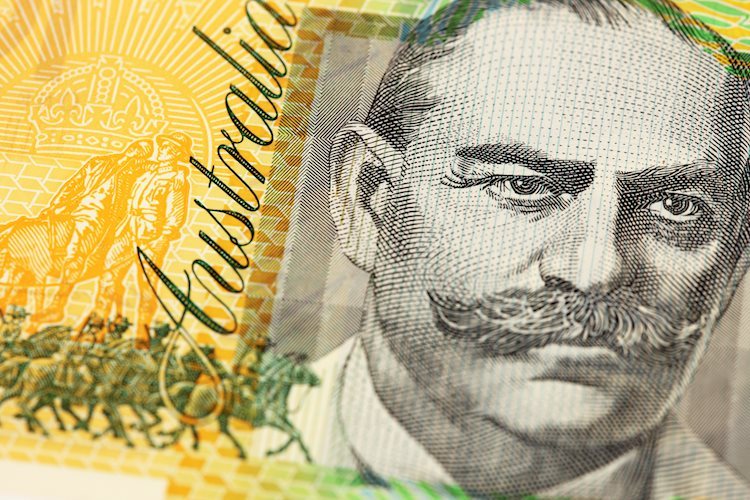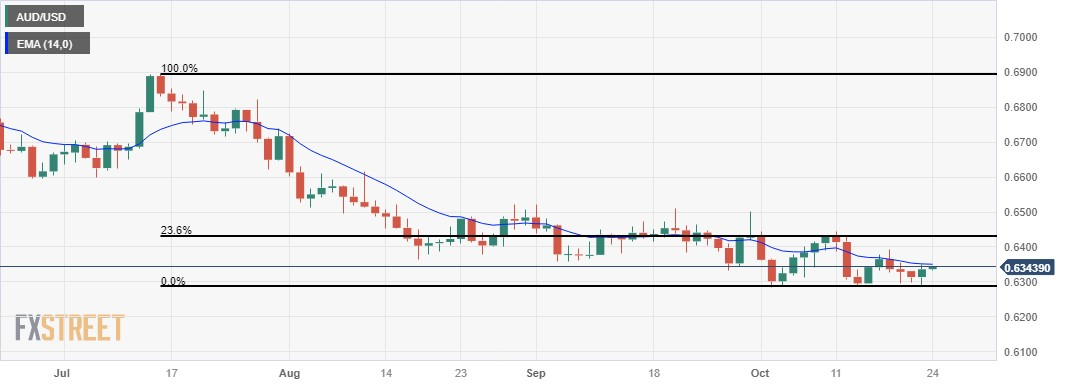- Australian Dollar extends gains as the US Dollar declines.
- Australia’s Manufacturing PMI eased to 48.0, while the Services PMI dropped to 47.6.
- China may approve over 1 trillion yuan in additional sovereign debt issuance.
- The pullback in US Treasury yields is weighing on the Greenback.
The Australian Dollar (AUD) aims to trade in the positive territory on Tuesday, extending its gains for the second successive day. The AUD/USD pair receives upward support due to the correction in the US Dollar (USD), which could be attributed to the downbeat US Treasury yields.
Australia’s preliminary S&P Global Manufacturing and Services PMI for October eased, suggesting a contraction in both the manufacturing and services sectors. Markets expect the Reserve Bank of Australia (RBA) to tighten policy further. RBA Governor Michele Bullock stated that should inflation persist above the projected levels, the RBA is prepared to enact suitable policy measures.
China is reportedly planning to approve slightly over 1 trillion yuan in additional sovereign debt issuance, as per a Reuters report citing three unnamed sources. The move is part of the Chinese Communist Party’s efforts to increase infrastructure spending and stimulate economic growth. The standing committee of the National People’s Congress (NPC) is expected to give the green light for the extra debt issuance on the final day of a meeting.
The US Dollar Index (DXY) seems set to extend its four-day losing streak, possibly influenced by downbeat US Treasury yields. After reaching its highest point since 2007, the 10-year Treasury yield took a U-turn, leading to a bit of selling pressure on the US Dollar (USD).
As per the CME FedWatch Tool, the likelihood of a November rate hike isn’t perceived by the markets. However, the odds for January 2024 still hover above 30%.
Daily Digest Market Movers: Australian Dollar extends its gains on downbeat US Dollar
- Australian S&P Global Composite PMI for October declined to 47.3 from the previous reading of 51.5. Manufacturing PMI eased to 48.0 compared to the prior figure of 48.7, while the Services PMI fell back into contraction, dropping to 47.6 from the previous month’s reading of 51.8.
- Westpac’s Chief Economist, Luci Ellis stated in a note that the core view presented that the Consumer Price Index (CPI) is expected to continue tracking lower and return to the RBA’s 2-3 percent target band in 2025, aligning with the central bank’s own expectations.
- Ellis highlighted several broader risks to the economy and inflation outlook that are being closely monitored. These include the resurgence of housing prices to levels close to pre-pandemic peaks, a global rise in bond yields, and China’s slower-than-expected recovery from a prolonged period of COVID-related lockdowns.
- Australia’s Unemployment Rate for September surprised on the positive side, coming in at 3.6% compared to the expectations of 3.7%, which was expected to remain consistent.
- Australian Employment Change for the same month was 6.7K, falling short of the consensus forecast of 20K. This is a notable decline from the 64.9K jobs added in August.
- Australia’s central bank expresses heightened concern about the inflation impact stemming from supply shocks. Governor of the Reserve Bank of Australia, Michele Bullock stated that if inflation persists above projections, the RBA will take responsive policy measures. There is an observable deceleration in demand, and per capita consumption is on the decline.
- China is set to host a significant financial policy meeting early next week, occurring once every five years. The primary objectives of this gathering are to proactively address and mitigate risks and to establish medium-term priorities for the expansive $61 trillion financial industry.
- Atlanta Fed President Raphael Bostic said on Friday that he believes the US central bank is unlikely to lower interest rates before the middle of next year. Fed Philadelphia President Patrick Harker reiterated his inclination to maintain interest rates.
- Fed Cleveland President Loretta Mester indicated that the US central bank is “at or near the peak of the rate hike cycle.” However, Mester acknowledged that the data released during the previous week could influence the central bank’s decision regarding the future of monetary policy.
- US weekly Initial Jobless Claims declined to 198K, falling short of the market expectations of 212K for the week ending October 14, the lowest level since January.
- Existing Home Sales Change fell 2.0% MoM in September and Existing Home Sales improved to 3.96M.
- US Unemployment Rate improved to 3.6%, which was expected to remain consistent at 3.7% in September.
- The 10-year Treasury yield surged to 5.02%, marking its first time at such levels since 2007. However, it promptly reversed direction, experiencing a decline of 4.86%.
- Market participants will closely monitor the US S&P Global PMI on Tuesday, the Q3 Gross Domestic Product (GDP) on Thursday, and the Core Personal Consumption Expenditures (PCE) on Friday. The attention will also be focused on the RBA Governor Bullock’s speech and the Consumer Price Index (CPI).
Technical Analysis: Australian Dollar hovers below 14-day EMA lined up with 0.6350 major level
The Australian Dollar hovers around 0.6340 on Tuesday, aligning with a crucial resistance around the 14-day Exponential Moving Average (EMA) at 0.6349, following a major level at 0.6400. A breakthrough above this resistance holds the potential to reach around the 23.6% Fibonacci retracement level at 0.6429. On the downside, the notable support emerges at the 0.6300 level followed by the monthly low at 0.6285.
AUD/USD: Daily Chart
Australian Dollar price today
The table below shows the percentage change of Australian Dollar (AUD) against listed major currencies today. Australian Dollar was the strongest against the Swiss Franc.
| USD | EUR | GBP | CAD | AUD | JPY | NZD | CHF | |
| USD | -0.04% | -0.05% | -0.03% | -0.10% | -0.05% | -0.07% | 0.00% | |
| EUR | 0.03% | -0.03% | 0.00% | -0.08% | -0.04% | -0.04% | 0.03% | |
| GBP | 0.05% | 0.03% | 0.03% | -0.05% | 0.01% | -0.01% | 0.05% | |
| CAD | 0.02% | -0.01% | -0.03% | -0.09% | -0.04% | -0.05% | 0.02% | |
| AUD | 0.10% | 0.08% | 0.06% | 0.09% | 0.06% | 0.03% | 0.12% | |
| JPY | 0.07% | 0.00% | -0.02% | 0.04% | -0.04% | 0.00% | 0.05% | |
| NZD | 0.05% | 0.02% | 0.01% | 0.04% | -0.05% | 0.01% | 0.06% | |
| CHF | 0.00% | -0.03% | -0.05% | -0.02% | -0.11% | -0.05% | -0.06% |
The heat map shows percentage changes of major currencies against each other. The base currency is picked from the left column, while the quote currency is picked from the top row. For example, if you pick the Euro from the left column and move along the horizontal line to the Japanese Yen, the percentage change displayed in the box will represent EUR (base)/JPY (quote).
Australian Dollar FAQs
One of the most significant factors for the Australian Dollar (AUD) is the level of interest rates set by the Reserve Bank of Australia (RBA). Because Australia is a resource-rich country another key driver is the price of its biggest export, Iron Ore. The health of the Chinese economy, its largest trading partner, is a factor, as well as inflation in Australia, its growth rate and Trade Balance. Market sentiment – whether investors are taking on more risky assets (risk-on) or seeking safe-havens (risk-off) – is also a factor, with risk-on positive for AUD.
The Reserve Bank of Australia (RBA) influences the Australian Dollar (AUD) by setting the level of interest rates that Australian banks can lend to each other. This influences the level of interest rates in the economy as a whole. The main goal of the RBA is to maintain a stable inflation rate of 2-3% by adjusting interest rates up or down. Relatively high interest rates compared to other major central banks support the AUD, and the opposite for relatively low. The RBA can also use quantitative easing and tightening to influence credit conditions, with the former AUD-negative and the latter AUD-positive.
China is Australia’s largest trading partner so the health of the Chinese economy is a major influence on the value of the Australian Dollar (AUD). When the Chinese economy is doing well it purchases more raw materials, goods and services from Australia, lifting demand for the AUD, and pushing up its value. The opposite is the case when the Chinese economy is not growing as fast as expected. Positive or negative surprises in Chinese growth data, therefore, often have a direct impact on the Australian Dollar and its pairs.
Iron Ore is Australia’s largest export, accounting for $118 billion a year according to data from 2021, with China as its primary destination. The price of Iron Ore, therefore, can be a driver of the Australian Dollar. Generally, if the price of Iron Ore rises, AUD also goes up, as aggregate demand for the currency increases. The opposite is the case if the price of Iron Ore falls. Higher Iron Ore prices also tend to result in a greater likelihood of a positive Trade Balance for Australia, which is also positive of the AUD.
The Trade Balance, which is the difference between what a country earns from its exports versus what it pays for its imports, is another factor that can influence the value of the Australian Dollar. If Australia produces highly sought after exports, then its currency will gain in value purely from the surplus demand created from foreign buyers seeking to purchase its exports versus what it spends to purchase imports. Therefore, a positive net Trade Balance strengthens the AUD, with the opposite effect if the Trade Balance is negative.

